
7. Use caution when operating the heat gun. Keep the heat gun moving as excessive heat will
generate fumes which can be inhaled by the operator.
8. Keep food and drink out of the work area. Wash hands, arms and face and rinse mouth
before eating or drinking. Do not smoke or chew gum or tobacco in the work area.
9. Clean up all removed paint and dust by wet mopping the floors. Use a wet cloth to clean
all walls, sills and any other surface where paint or dust is clinging. DO NOT SWEEP, DRY
DUST OR VACUUM. Use a high phosphate detergent or trisodium phosphate (TSP) to wash
and mop areas.
10. At the end of each work session put the paint chips and debris in a double plastic bag, close
it with tape or twist ties and dispose of properly.
11. Remove protective clothing and work shoes in the work area to avoid carrying dust into the
rest of the dwelling. Wash work clothes separately. Wipe shoes off with a wet rag that is then
washed with the work clothes. Wash hair and body thoroughly with soap and water.
IMPORTANT NOTICE
In order for this tool to be an effective paint stripper, it must produce extremely high temperatures.
As a consequence, the stripper is capable of igniting paper, wood, paint and varnish residue and
similar materials.
As you become more familiar with the tool and develop the proper technique, the danger of
accidental ignition will be greatly reduced. In establishing the proper technique, the best thing to
do is PRACTICE! Work on simple stripping projects, preferably outdoors, until you get a “feel” for
how to use your stripper safely and effectively.
AS YOU PRACTICE, OBSERVE THE FOLLOWING PROCEDURES FOR SAFETY
• Always be sure the tool is turned off and disconnected from power supply when unattended.
• Clean the scraper blade often during use. Built up residue on the blade is highly flammable.
• Experiment to find the optimum distance from the tool’s nozzle to the surface being stripped.
This distance [1"–2" (25.4 mm–50.8 mm)] will vary depending on the material being
removed.
• Keep the heat gun moving ahead of the scraper blade at all times.
• As you work, clean up loose pieces of paint as they accumulate around the work area.
• When working indoors, keep away from curtains, papers, upholstery and similar flammable
materials.
• Above all, remember that this is a serious tool that is capable of producing excellent results
when used properly. Practice on simple projects until you feel comfortable with your stripper.
Only then will you have mastered the proper technique.
SAVE THESE INSTRUCTIONS FOR FUTURE USE
Description (Fig. 1)
WARNING: Never modify the tool or any part of it. Damage or personal injury could result.
A. On/off switch
B. Air vents
C. Kick-off stand
D. Air temperature adjustment knob (D26950)
LCD air temperature indicator and adjuster (D26960)
E. Nozzle
F. Tool hanging ring
G. Heat barrel cover
INTENDED USE
Your D
EWALT heat gun has been designed for stripping paint, soldering pipes, shrinking PVC,
welding and bending plastics as well as general drying and thawing purposes.
WARNING: DO NOT use under wet conditions or in presence of flammable liquids or gases.
The heat gun is a professional power tool. DO NOT let children come into contact with the tool.
Supervision is required when inexperienced operators use this tool.
ASSEMBLY AND ADJUSTMENTS
WARNING: To reduce the risk of injury, turn off tool, disconnect from power source and
allow to cool before installing and removing accessories, before making any adjustments or
removing/installing attachments or accessories.
Air Temperature (Fig. 1)
D26950
The air temperature can be adjusted to suit a wide range of applications. Turn the air temperature
adjustment knob (D) clockwise or counterclockwise for higher or lower heat.
D26960
Press and release the LCD air temperature indicator and adjuster (D) to set the desired
temperature in 50˚F (10˚C) increments. To continously increase or decrease the temperature
press and hold the LCD air temperature indicator and adjuster (D). Release the indicator when
desired temperature or minimum/maximum temperature is reached.
The display shows the actual rising/falling temperature until the desired temperature is
reached.
SET AND FORGET TEMPERATURE CONTROL SYSTEM
D26960
The desired temperature is stored in the memory of the tool. Each time the heat gun is turned
on, the heat gun heats to the last temperature setting, with respect to air flow. If unsure about
the setting, always start with a low temperature setting and gradually increase the temperature
until the desired setting is reached.
Applications
The table below suggests settings for different applications.
Setting Applications
Low • Drying paint and varnish
• Removing stickers
• Waxing and dewaxing
• Drying wet timber prior to filling
• Shrinking PVC wrapping and
insulation tubes
• Thawing frozen pipes
High • Welding plastics
• Bending plastic pipes and sheets
• Loosening rusted or tightly
fastened nuts and bolts
• Removing paint and lacquer
• Soldering plumbing joints
• Removing linoleum or vinyl floor tiles
To Attach the Correct Accessory
This tool is supplied with a set of accessories for different applications.
Icon Description Purpose
Cone nozzle Welding, soldering,
shrink sleeving (heat over
concentrated small area)
2" (50 mm) Drying, removing paint,
Fish tail removing vinyl or linoleum,
surface nozzle thawing (heat spread over wide area)
1. Make sure the on/off switch (A) is in position O and the tool is disconnected from the power
source. Ensure the nozzle has cooled down.
2. Place the desired accessory onto the nozzle.
OPERATION
WARNING: Make sure the nozzle ALWAYS points away from you and any bystanders.
WARNING: DO NOT drop anything into the nozzle.
WARNING: Use only one hand to hold the tool as shown in Figure 2. Do not place your other
hand over the air vents (Fig. 3).
PRIOR TO OPERATION
1. Attach the correct accessory recommended for the application.
2. Turn the air temperature adjustment knob (D) to desired air temperature.
Switching On and Off (Fig. 4)
1. Push the on/off switch (A) to the desired air flow settings:
A low air flow to heat up the workpiece slowly.
I: 8.5 CFM [120–750˚F (50˚–400˚C)]
8.8 CFM [150–750˚F (65˚–400˚C)] (D26960)
A high air flow to heat up the workpiece quickly.
II: 16 CFM [120–1100˚F (50˚–600˚C)]
17.7 CFM [(150–1100˚F) (65˚–600˚C)] (D26960)
2. To turn the tool off, push the on/off switch (A) to position O. Disconnect the tool from the
power source and let the tool cool down before moving or storing it.
Removing Paint
WARNING: Refer to Important Notice under Additional Safety Instructions for Heat Guns
before using the tool to remove paint.
WARNING: Do not strip metal window frames as the heat may crack the glass.
• When striping other window frames, use a glass protection nozzle.
• To prevent igniting the surface, do not keep the tool directed at one spot too long.
• Avoid collecting paint on the scraper accessory, as it may ignite. If necessary, carefully
remove paint debris from the scraper accessory using a knife.
1. Attach the appropriate accessory.
2. Turn the air temperature adjustment knob (D) to high.
3. Turn the tool on by selecting the desired air flow.
4. Direct the hot air onto the paint to be removed.
Best results will be achieved if the heat gun is moved slowly, but CONSTANTLY, from side to
side to evenly distribute heat. DO NOT LINGER OR PAUSE IN ONE SPOT.
5. When the paint softens, scrape the paint away using a hand scraper.
REMEMBER: Splinters and small particles of stripped paint can be ignited and blown through
holes and cracks in the surface being stripped.
Stationary Use (Fig. 1)
This tool can also be used in stationary mode.
1. Fold down the kickstand (C) as shown in Figure 1.
2. Set the tool onto a level, stable workbench. Ensure the tool will not tip over.
3. Secure the power cord to prevent entanglement or pulling the tool off the workbench.
4. Turn the tool on by selecting the desired air flow.
Constant Heat Control (Overload Protection)
When the tool is overloaded, this feature protects the heating element from damage without
stopping the tool and/or without a cool down period.
1. When the temperature gets too hot, the heating element switches itself off. The motor will
continue to run and produce cold air.
2. When the temperature has cooled sufficiently (taking only a few seconds) the heating
element will switch on automatically.
Tool Ring (Fig. 1)
WARNING: ALWAYS turn heat gun off, disconnect from the power source and let the tool cool
down for at least 30 minutes before moving or storing it.
For easy storage, the tool can hang from the tool ring (F). The heat gun should be stored
indoors.
Cool Down Period
The nozzle and accessory becomes very hot during use. Turn heat gun off, disconnect from the
power source and let the tool cool down for at least 30 minutes before moving or storing it.
FIG. 2 FIG. 3
A
FIG. 4
FIG.1
A
C
B
D
E
F
G
D26950
A
C
B
D
E
F
G
D26960

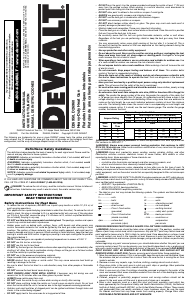




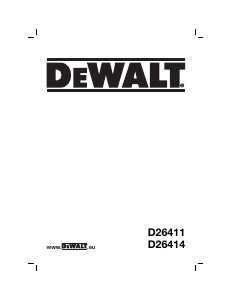

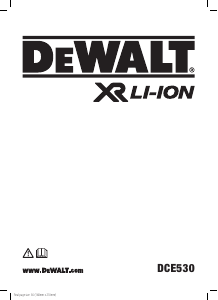
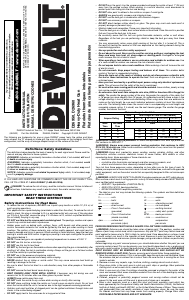
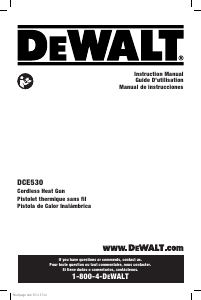

Praat mee over dit product
Laat hier weten wat jij vindt van de DeWalt D26950 Heteluchtpistool. Als je een vraag hebt, lees dan eerst zorgvuldig de handleiding door. Een handleiding aanvragen kan via ons contactformulier.